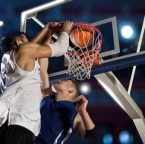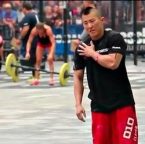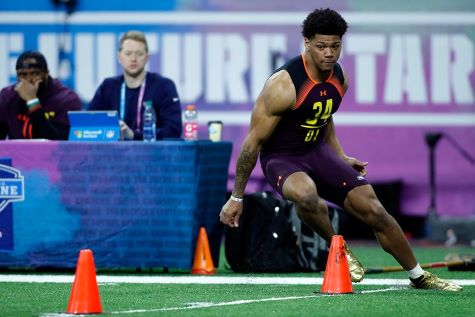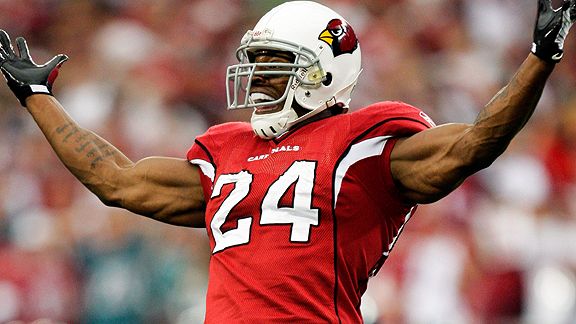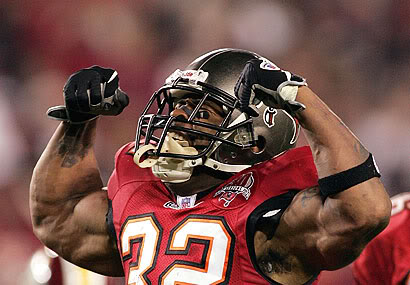It’s become a comedic trope in movies when a basketball game takes place. You see the star player go one-on-one against an underdog who doesn’t seem to have any real talent.
The star player taunts the underdog, showing his complicated dribbling skills. Suddenly, he no longer has the ball. Then you see the underdog with a sheepish smile holding the ball.
This lightspeed reaction is an example of speed, agility, and quickness, one of the most important sets of skills that a basketball player (or any athlete) should develop to see dramatic improvements in performance.
Let’s take a closer look at agility in particular, the benefits of agility training, and a series of basketball agility drills that you can start using today to develop your performance.
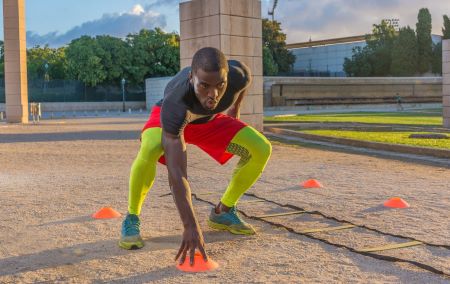
What is Agility?
It’s easy to mistake the simple act of running fast as agility; after all, speed is a characteristic of agility but there’s more to it than that.
Agility is an ability that is comprised of three key elements:
- Starting (acceleration)
- Stopping while maintaining stabilization (deceleration)
- Changing direction while maintaining postural control
Agility emphasizes an athlete’s ability to perform the last of these: changing direction, especially in mid-run.
Naturally, agility is going to require an incredible level of coordination and balance because you are going to shift direction at a variety of speeds while maintaining complete control over your center of gravity.

Benefits of Agility Training
There are numerous benefits to focusing on speed, agility, and quickness training or SAQ training that extend to those beyond the athletic population.
Dynamic Flexibility: Agility training and dynamic or active stretching have a unique relationship where one improves the other. The training and care of connective tissue and fast-twitch muscle fibers ensures a progressive development in performance. [2]
Postural Control: Agility training places an enormous emphasis on proper core development and neuromuscular control. In other words, this type of training improves the body’s ability to react to a given stimulus. For example, if a player is rushing an athlete, he/she will be able to react quickly to avoid a stolen ball or blocked shot. In everyday life, agility can help to react to your environment such as a falling object or clumsy person. [3]
Core Strength: Continuing with the point above, the core musculature gets incredibly strong during agility training. The core is where all movement originates. Agility training focuses on the ability to move as quickly and safely as possible in a given direction during acceleration or immediately after deceleration. This is why the core experiences a significant increase in strength, especially the deeper, non-superficial muscles such as the transversus abdominis. [3]
Proprioception: Agility training has been shown to dramatically improve proprioception, which is how your body makes sense of where it is in relation to its surroundings. For example, if you are jogging and you see a puddle, your body can react accordingly based on the sensory information that you perceived. [3]
Reduced Risk of Injury: Finally, studies show that SAQ training reduces your risk for injury in two important ways: First, it improves the way your body controls a given load in different planes of motion. For example, twisting around to avoid having a shot blocked then recentering and taking that shot. Second, agility training significantly improves the structural integrity of connective tissue (e.g., your ankle and knee) during quick-thinking situations. [4]
Related: 3 Great Ways to Improve Agility
Agility Training for Basketball Players
How do the benefits of agility training translate over to the game of basketball?
Better Handling: Thanks to improved proprioception, basketball players will be able to better handle the ball while moving around the court.
Faster Reaction Times: Agility training improves both your body’s awareness of your environment as well as how to react to that environment. Basketball players can enjoy the benefit of faster reaction times during games.
Increased Speed: As mentioned above, agility training will naturally lend itself to better speed since the drills require all-out effort with sprinting, side shuffles, etc.
Overall Better Performance: From an enhanced awareness of the court to the heightened ability of reaction, agility training can help to improve the overall performance of basketball players.
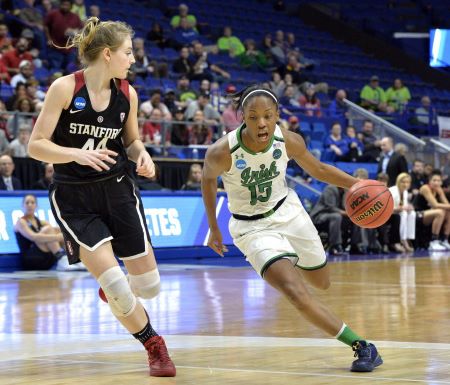
Basketball Agility Drills
There are dozens of agility drills that you can perform to improve your game, but I’ve included the collection of drills that I personally use for clients who are basketball players.
These agility drills for basketball players can be broken down into two categories: ladder drills and cone drills.
Speed Ladder Drills
In order to perform these drills, you’ll need a speed ladder and a good amount of space. Be sure to watch each video a few times and start off with practicing the footwork slowly as you build up speed.
One-Ins: This is a pattern of footwork where each foot climbs into the subsequent ladder rung.
Two-Ins: Each foot must go into a rung before moving on to the next one.
In-In-Out-Out: Each foot steps inside of the rung then immediately to the outside of the ladder before progressing forward.
Zig Zag (In-In-Out): You’ll form a zig-zag pattern as your feet both enter the rung but only one step to the outside of the ladder.
Side Shuffle: This is the first horizontal drill. Each foot will enter the rung before progressing to the next one.
Ali Shuffle: Another horizontal drill, this shuffle involves stepping forward, backward, and to the side as you shuffle your way down the ladder.
Cone Drills
In order to perform these drills, you’ll need a set of cones. I also recommend utilizing an open field or a gymnasium floor if you have access to one. Again, be sure to watch each video a few times and start off with practicing the footwork slowly as you build up speed.
5-10-5 Drill: Begin at the middle cone. Sprint to the right cone, to the far-left cone, then back to the middle cone.
Box Drill: Sprint to the top right cone, side shuffle to the top left cone, backpedal to the bottom left cone, carioca to the starting cone.
Modified Box Drill: Begin at the middle cone. Have a friend call out a cone number and you sprint to that cone.
T-Drill: Begin at the bottom of the “T”. Sprint to the middle cone, side shuffle to the far-left cone, carioca to the far-right cone, side shuffle to the middle cone, then backpedal to the starting cone.
Related: Dominate the Basketball Court With These Exercises
Related: 5 Benefits of Doing Cone Drills
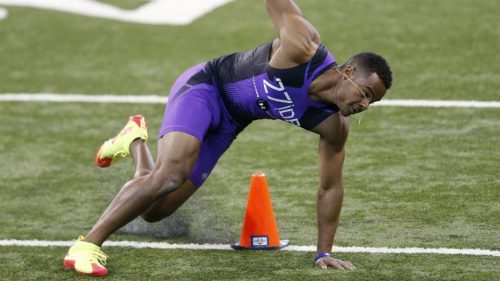
Agility Training is a Piece of the Puzzle
There’s no denying the benefits of agility training for basketball players but these workouts should be a piece of the bigger puzzle. It’s important that SAQ training is complemented by resistance training, cardiovascular fitness, and plyometric drills.

David J. Sautter has combined a lifelong passion for writing with over a decade of experience as an NASM-certified personal trainer, fitness-nutrition specialist, and sports-conditioning specialist. David has written hundreds of blog posts as well as dozens of e-books, training guides, and online courses covering a range of health and fitness topics. In his free time, David enjoys writing about staying fit while traveling abroad for his blog, FitnessWanders.com. Learn more about David Sautter at WriteFit.com.
References
- Sutton, Brian G. “Chapter 19: Speed, Agility, and Quickness Training Concepts.” NASM Essentials of Personal Fitness Training, Seventh ed., Jones & Barlett Learning, 2020, pp. 595–604.
- Van Gelder, Leonard H; Bartz, Shari D The Effect of Acute Stretching on Agility Performance, Journal of Strength and Conditioning Research: November 2011 – Volume 25 – Issue 11 – p 3014-3021 doi: 10.1519/JSC.0b013e318212e42b.
- Morat M, Faude O, Hanssen H, Ludyga S, Zacher J, Eibl A, Albracht K, Donath L. Agility Training to Integratively Promote Neuromuscular, Cognitive, Cardiovascular and Psychosocial Function in Healthy Older Adults: A Study Protocol of a One-Year Randomized-Controlled Trial. Int J Environ Res Public Health. 2020 Mar 12;17(6):1853. doi: 10.3390/ijerph17061853. PMID: 32178430; PMCID: PMC7143005.
- Hrysomallis C. Relationship between balance ability, training and sports injury risk. Sports Med. 2007;37(6):547-56. doi: 10.2

